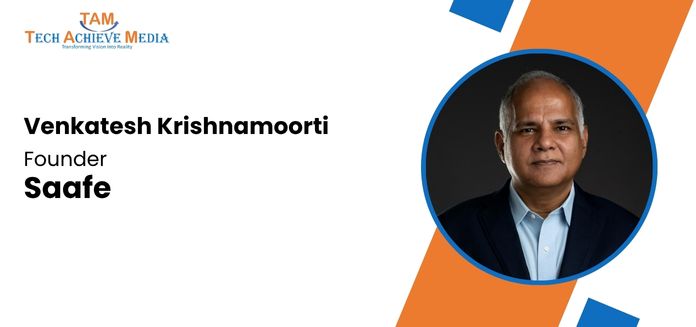As India’s financial landscape embraces the next phase of digital transformation, Account Aggregation (AA) has emerged to become extremely pertinent for consent-based data sharing and financial inclusion. Venkatesh Krishnamoorti, Founder of Saafe, whose dual NBFC-AA and TSP model is helping financial institutions and citizens alike navigate the complexities of secure data exchange, is championing this cause. In an exclusive interaction with Tech Achieve Media, Krishnamoorti discusses the accelerating adoption of the Account Aggregator ecosystem, Saafe’s commitment to building trust through transparency, and how innovations like Saafe 360 Analytics are enabling smarter, data-driven lending decisions across India’s expanding open finance network.
TAM: How do you view the evolution of India’s Account Aggregator ecosystem, and what inflection point are we witnessing today in terms of adoption and regulatory maturity?
Venkatesh Krishnamoorti: Like any developing economy, the population of India using mainstream banking was sub-optimal. Concerted actions including Demonitisation, Digital Public Infrastructure, Jan Dhan, Direct Benefit Transfers, GST etc have accelerated shift from cash-based economy to banking channels. Importance of a credit history & score to enable access to competitive credit has also nudged self-employed, MSME owners to channelize their flows thru banks.
Developments of last 10-12 years have made availability of rich data about Citizens’ finances. Lending decisions, which hitherto had to rely on inefficient and vulnerable data, are now made wholistically with innumerable data points, triangulations. Account Aggregation has emerged as a critical enabler for Financial Institutions & Citizens for access and sharing respectively. While the first year of AA adoption was tepid, we are witnessing rapid growth rates of adoption by all categories of Financial Institutions. Citizens are proactively using AA as the default mode of sharing their data securely and swiftly.
TAM: In an era where data privacy is paramount, how is Saafe redefining trust and transparency in the open banking landscape?
Venkatesh Krishnamoorti: Citizens have been using AA rails to share data by approving the consent requests from Fis. We, at SAAFE, always believed that approving the consent for sharing data is only a start. Towards this end, we built a best-in-class app (in Android & iOS) to help Citizens have a one-view of their financial assets and manage their consents. In addition to providing a dashboard of all their consents, features to pause, revoke consents are very important for Citizens, especially with DPDP Act. As an AA, we differentiated ourselves from others by focussing on B2C as much as B2B.
As DPDP gets fully enforced in coming quarters and years, Consent management for Citizens will take centre stage. With RBI license, AAs would benefit as a “trusted” entity unlike unregulated entities that have for years, sought access to SMS and Emails for customer service.
Complete details of consent artefact, multi-lingual to ensure we serve not just India but the larger Bharat, compliance with ecosystem guidelines are critical factors for gaining trust and ensuring transparency.
TAM: What strategic edge does Saafe gain from operating under a dual NBFC-AA and TSP model, and how does it enhance collaboration with financial institutions?
Venkatesh Krishnamoorti: Financial Institutions, like any corporate, are better placed to deal with fewer 3rd parties who can provide all solutions and services that they require. By design, SAAFE started its journey with the objective of building a reliable AA partner for Fis as Phase-I and TSP as Phase-II. After reaching critical mass in the AA venture, we commenced and completed the TSP build in a short span of 6 months. Our TSP product design is the most complete offering, drawing on our experience and noting the gaps that earlier TSPs had, in their solutions of FIs.
A TSP-AA combined offering doesn’t necessarily guarantee success. Understanding the medium / long term plans of FIs and building features to address them proactively is key. Additionally, our experience in Financial services hold us in good stead for conceptualizing innovative & efficient ideas.
SAAFE AA has earned strong credibility and reputation with its FI clients over the last 2 years and well-placed to leverage this goodwill for its cutting-edge TSP solutions. TSP-AA combination is invaluable for deeper, wider and broader engagement across verticals in FIs.
TAM: How are innovations like Saafe 360 Analytics empowering financial players to make smarter, data-led lending and risk management decisions?
Venkatesh Krishnamoorti: Credit underwriting has evolved over the years with more data points becoming available for consideration. From an era where only bank statement was relied upon, today, financial data and non-financial data is utilized to make an efficient lend/decline decision. SAAFE 360 provides Income verification, Employment verification, Credit score, Bank statement analysis, KYC, Bank account verification, Income tax filing data, Residence stability, Social media data, GST filing data etc. These are compiled and triangulated, wherever applicable, for underwriting decisions.
AA has also ushered in a few innovative options for lenders – Monitoring consent (subject to approval by the Citizen) affords periodic insights into the borrowers’ financials for assessing financial wellbeing during the tenure of loan. This helps in Early warning signals in case of weakening in cash flows. Further, collections have become efficient with “Balance enquiry” on daily basis which can be used tactically and in a targeted manner for EMI skip cases.
TAM: As India moves toward open finance, what is Saafe’s roadmap for scaling adoption across banks, NBFCs, and fintechs while ensuring security and inclusivity through consent-based data sharing?
Venkatesh Krishnamoorti: We believe that AA has the power to make competitive credit accessible for all sections of the population irrespective of Tier 1 or Tier 4 residence. AA rails have not only crashed the time taken to process loans (from days to minutes), they have also made it error/fraud proof as data inputs flow directly & securely from sources of truth. When loan portfolios get more healthier with efficient underwriting & regular monitoring, lenders have the confidence to scale up their balance sheets.
Recent spate of cybercrimes and scams have woken up the citizens to danger of their data – personal and financial getting compromised and misused. While there is need for lot more efforts from Government, Regulators and Private Institutions to make citizens aware of the need to keep data secure, we are already witnessing a growing trend in this direction. AA adoption by Citizens is largely assisted by the Financial Institutions for ease of processing the loan application. The significant collateral benefit is data security for Citizens. As citizens become more aware of DPDP and its purpose, it will accelerate clear consent-based sharing of data by Citizens. AA is a precursor to DPDP, in putting the power & control of data in the hands of citizens.
Financial institutions have greater responsibility to handle the data with care and put it to use only for the purpose explicitly stated at the time of collection. Any breach entails substantial penalties under the DPDP Act.









